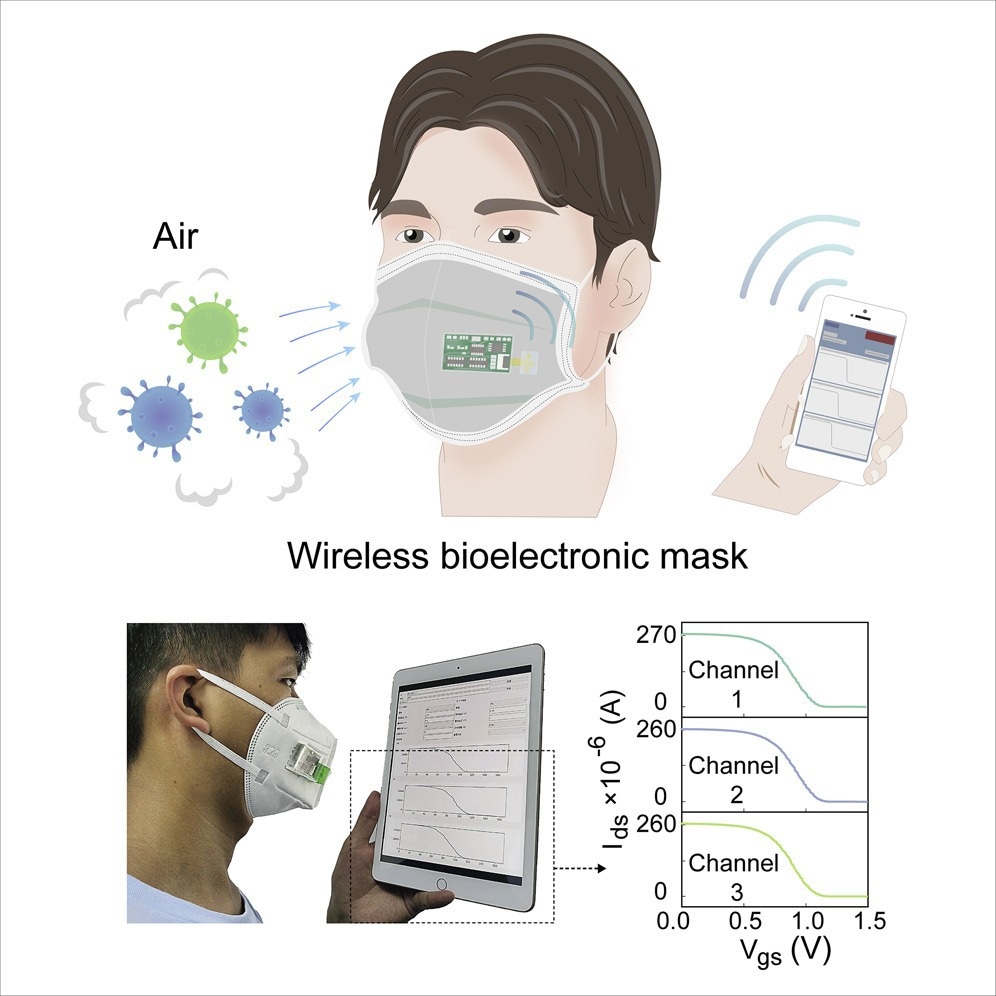As the world is still adjusting to the events of the COVID-19 pandemic, finding ways to detect the spread of pathogens is key to mitigating any future spread of deadly diseases. Therefore, detecting, diagnosing, responding to, and containing future communicable diseases is crucial when it comes to ensuring maximum survival and minimal disruption to society at large.

Image Credit: Wang, B., Yang, D., Chang, Z., Zhang, R., Dai, J. and Fang, Y., (2022) Wearable bioelectronic masks for wireless detection of respiratory infectious diseases by gaseous media. Matter, [online] Available at: https://www.cell.com/matter/fulltext/S2590-2385(22)00477-5?_returnURL=https%3A%2F%2Flinkinghub.elsevier.com%2Fretrieve%2Fpii%2FS2590238522004775%3Fshowall%3Dtrue
Now, a team of researchers from Tongji University School of Medicine has revealed a wearable bioelectronic facemask that could serve as an early warning system when wearers come into contact with certain viral pathogens.
The bioelectronic device mounted outside the mask can directly analyze infectious viruses in the air. Meanwhile, the wireless data feedback is acquired on the mobile device in real time.
Dr. Yin Fang, Tongji University’s School of Medicine
The ‘smart’ facemask, which can detect a range of common respiratory diseases, including COVID-19, influenza, and the common cold, can alert wearers if they have come into contact with the disease via an app on a smartphone. With wearable smart devices becoming increasingly popular, the rich data they collect could lead to more accurate disease diagnosis and precision treatment plans.
Biosensing Facemasks
To create the biosensing facemask, the team incorporated ion-gated transistors that are specifically developed for testing viral proteins. Additionally, a stretchable ionic gel that was synthesized using a two-solvent system functions as a dielectric layer for the ion-gated transistors. This setup allows the bioelectronic facemask to detect both trace liquid samples and gaseous media samples.
Moreover, the team reports that the mask has multi-channel analysis and can rapidly detect the presence of viruses and feed this information back to the user using IoT technology and a smartphone app. This makes for an effective and dynamic detection device for common respiratory illnesses and could, in effect, be a powerful tool to prevent further outbreaks of common and deadly diseases.
Integrating a wireless internet of things system enables the wearable mask to achieve real-time and on-site detection of the surrounding air, providing an alert before infection. The wearable bioelectronic masks hold promise to serve as an early warning system to prevent outbreaks of respiratory infectious diseases.
Dr. Yin Fang, Tongji University’s School of Medicine
Advanced Diagnostic Techniques
While existing clinical diagnosis and testing methods, including quantitative polymerase chain reaction with reverse transcription (RT-PCR), and enzyme-linked immunosorbent assay (ELISA), proved to be effective in the fight against COVID-19, these tests focus on analyzing samples collected from individuals that are either infected or suspect an infection. Therefore, these tests do not serve as an effective diagnosis method to detect the presence of viral pathogens in the surrounding environment.
Thus, Fang and the team wanted to create a mask that could detect the presence of viruses in the surrounding air and send an alert to the wearer to let them know of potential exposure. This would be useful in enclosed spaces and locations where the risk of person-to-person transmission is greater.
The mask is able to detect the presence of viral diseases within 10 minutes and at low concentrations, and the team reported that the biosensing capabilities of the facemask are tunable so that new and emerging diseases can be detected if they pose a significant public health risk.
The team hopes that this technology will help to lead the way for a new and effective method for the detection of various respiratory diseases such as COVID-19 and could act as an innovative early warning system. The next steps for the team involve reducing the detection time to make it even more effective and seeing if there is application potential to translate this technology into the detection of other illnesses so that the team can continue their work on wearable bioelectronic devices for disease detection.
References and Further Reading
Wang, B., Yang, D., Chang, Z., Zhang, R., Dai, J. and Fang, Y., (2022) Wearable bioelectronic masks for wireless detection of respiratory infectious diseases by gaseous media. Matter, [online] Available at: https://www.cell.com/matter/fulltext/S2590-2385(22)00477-5?_returnURL=https%3A%2F%2Flinkinghub.elsevier.com%2Fretrieve%2Fpii%2FS2590238522004775%3Fshowall%3Dtrue
Disclaimer: The views expressed here are those of the author expressed in their private capacity and do not necessarily represent the views of AZoM.com Limited T/A AZoNetwork the owner and operator of this website. This disclaimer forms part of the Terms and conditions of use of this website.